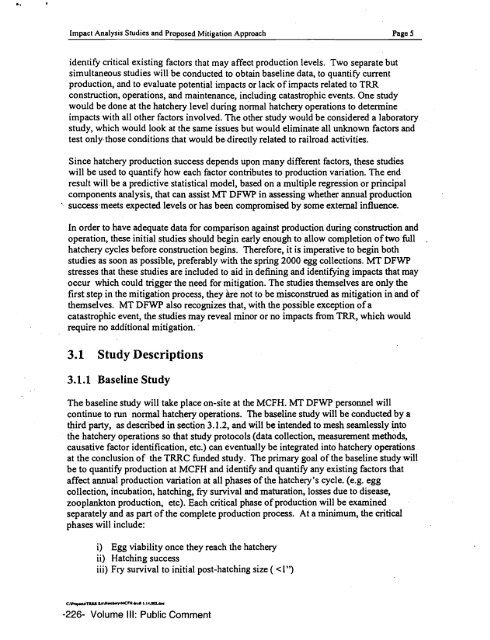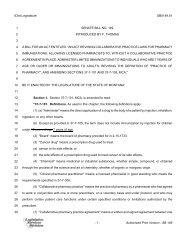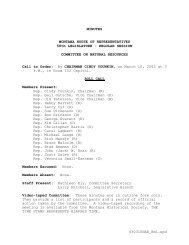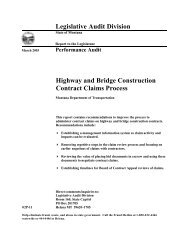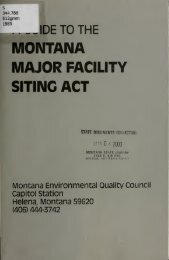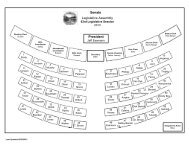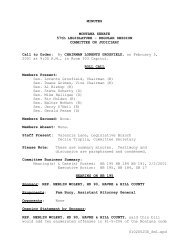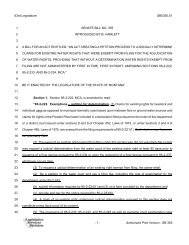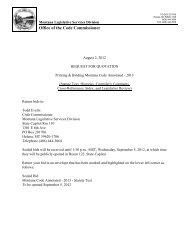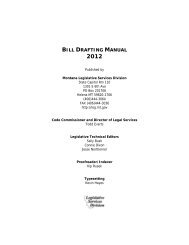Public Comment. Volume III - Montana Legislature
Public Comment. Volume III - Montana Legislature
Public Comment. Volume III - Montana Legislature
You also want an ePaper? Increase the reach of your titles
YUMPU automatically turns print PDFs into web optimized ePapers that Google loves.
Impact Analysis Studies and Proposed Mitigation Approach Page 5<br />
identify critical existing factors that may affect production levels. Two separate but<br />
simultaneous studies will be conducted to obtain baseline data, to quantify current<br />
production, and to evaluate potential impacts or lack of impacts related to TRR<br />
construction, operations, and maintenance, including catastrophic events. One study<br />
would be done at the hatchery level during nonnal hatchery operations to determine<br />
impacts with all other factors involved. The other study would be considered a laboratory<br />
study, which would look at the same issues but would eliminate all unknown factors and<br />
test only. those conditions that would be.directly related to railroad activities.<br />
Since hatchery production success depends upon many different factors, these studies<br />
will be used to quantify how each factor contributes to production variation. The end<br />
result will be a predictive statistical model, based on a multiple regression or principal<br />
components analysis, that can assist MT DFWP in assessing whether annual production<br />
success.meets expected levels or has been compromised by some external influence.<br />
In order to have adequate data for comparison against production during construction and<br />
operation, these initial studies should begin early enough to allow completion of two full .<br />
hatchery cycles before construction begins. Therefore, it is imperative to begin both<br />
studies as soon as possible, preferably with the spring 2000 egg collections. MT DFWP<br />
stresses that these studies are included to aid in defining and identifying impacts that may<br />
occur which could trigger the need for mitigation. The studies themselves are only the<br />
first step in the mitigation process, they b e not to be misconstrued as mitigation in and of<br />
themselves. MT DFWP also recognizes that, with the possible exception of a<br />
catastrophic event, the studies may reveal minor or no impacts from TRR, which would<br />
require no additional mitigation.<br />
3.1 Study Descriptions<br />
3.1.1 Baseline Study<br />
The baseline study will take place on-site at the MCFH. MT DFWP personnel will<br />
continue to run normal hatchery operations. The baseline study will be conducted by a<br />
third party, as described in section 3.1.2, and will be intended to mesh searnlessly into<br />
the hatchery operations so that study protocols (data collection, measurement methods,<br />
causative factor identification, etc.) can eventually be integrated into hatchery operations<br />
at the conclusion of the TRRC hnded study. The primary goal of the baseline study will<br />
be to quantify production at MCFH and identify and quantify any existing factors that<br />
affect annual production variation at all phases of the hatchery's cycle. (e.g. egg<br />
collection, incubation, hatching, fry survival and maturation, losses due to disease,<br />
zooplankton production, etc). Each critical phase of production will be examined<br />
separately and as part of the complete production process. At a minimum, the critical<br />
phases will include:<br />
i) Egg viability once they reach the hatchery<br />
ii) Hatching success<br />
iii) Fry survival to initial post-hatching size ( < 1 ")<br />
C:-TUB u-mean 1.14.-<br />
-226- <strong>Volume</strong> Ill: <strong>Public</strong> <strong>Comment</strong>


